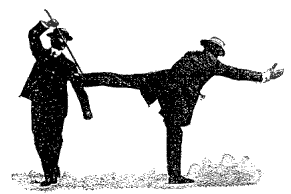 After graduating from college I lived for a time at my parents’ house, working in a local bookstore until I could find a job at least nominally related to computers. On a trip down to Ann Arbor to haunt the excellent used bookstores, I found a copy of Douglas Hofstadter’s Metamagical Themas at Dawn Treader.
After graduating from college I lived for a time at my parents’ house, working in a local bookstore until I could find a job at least nominally related to computers. On a trip down to Ann Arbor to haunt the excellent used bookstores, I found a copy of Douglas Hofstadter’s Metamagical Themas at Dawn Treader.
MT is a collection of Hofstadter’s Scientific American columns from 1981 to 1983, and it is a cornucopia of fascinating tangles. Chapter 4 describes the game of Nomic, invented by Peter Suber. If you’re not familiar with it, the concept behind the game is deceptively simple: the rules are changable, and the players take turns suggesting new rules.
A game of Nomic begins with an initial rule set designed to facilitate this self-modifying gameplay and to deal with common situations. For example:
107. No rule change may take effect earlier than the moment of the completion of the vote that adopted it, even if its wording explicitly states otherwise. No rule change may have retroactive application.
116. Whatever is not explicitly prohibited or regulated by a rule is permitted and unregulated, with the sole exception of changing the rules, which is permitted only when a rule or set of rules explicitly or implicitly permits it.
The initial rules for winning are simple: the first player to reach 100 (positive!) points wins. If a player proposes a rule that is accepted, they gain ten points. If their proposal is defeated, they lose ten points. Rule changes are adopted only with unanimous agreement, but some rules handle possible situations in the face of changed rules:
204. If and when rule changes can be adopted without unanimity, the players who vote against winning proposals shall receive 10 points apiece.
To keep things moving, in addition to proposing a rule each player also rolls a die and gains that many points. Of course, that rule is often the first one to go!
Upon returning home, I immediately drafted my younger brothers into a game. I had already written out the rules on individual 3″x5″ cards, and we went out to the back yard to start the game. The garage contained any number of game materials suitable for livening things up: bocce balls, a croquet set, Frisbees, an astonishing number of hula hoops, and so on. I figured that in addition to playing with the rules, we could add some interesting physical challenges. Both of my brothers were amenable, so play began.
We began by abolishing rules. I don’t recall exactly, but I’m pretty sure the first to go was rule 201:
201. Players shall alternate in clockwise order, taking one whole turn apiece. Turns may not be skipped or passed, and parts of turns may not be omitted. All players begin with zero points.
The ideas was that we would strip out the rules that didn’t match the kind of game we were working towards, and then build up a new set. We then went on to remove seveal other rules.
Suddenly, a problem became clear: Rule 201 was a very, very bad rule to remove. We no longer had any legal way to determine who would go next! We began discussing the problem. Disagreements arose.
An hour later, we were still arguing. The nub of the conflict was this: were any of the rule changes we had made after revoking rule 201 actually legal?
The game moved inside, and we were all getting hungry and tempers were getting short. As the argument continued, we split into two camps: M~ and I held that the game was always in some particular state, and by examining the rules closely enough we could determine exactly what that state was. K~ held that the historical aspect was irrelevant, and only the current ruleset was relevant for determining the state of the game.
We went on in this vein for quite some time, and K~ threatened to resign. I forstalled this by pointing out that he may actually have won. The last rule deals with paradoxes:
213. If the rules are changed so that further play is impossible, or if the legality of a move is impossible to determine with finality, or if by the Judge’s best reasoning, not overruled, a move appears equally legal and illegal, then the first player who is unable to complete a turn is the winner. This rule takes precedence over every other rule determining the winner.
As K~’s turn was right after mine, and I had proposed the abolition of 201, we all agreed that I had completed my turn, but K~ had been unable to complete his. Resolution!
My first game of Nomic was not a rousing success. For some reason, I was unable to get anyone interested in a second game.
Thank Eris for the Internet! A few years later I discovered online Nomics. These saw a real surge in popularity in the mid- to late-nineties. Sadly, most of these have now closed down. I particularly liked Acknomic, which had a highly-complex chess variant (Ackanomic Party Chess) as a sub-game. There are still a few running these days. As a starting point, see the database of active Nomics at nomic.net, which lists 13 as of this writing.
(Image of Dublin’s Lady of Justice courtesy of MacBuckley.)



 Robert Anton Wilson Wake and Erisian Festival
Robert Anton Wilson Wake and Erisian Festival I am agog.
I am agog.


